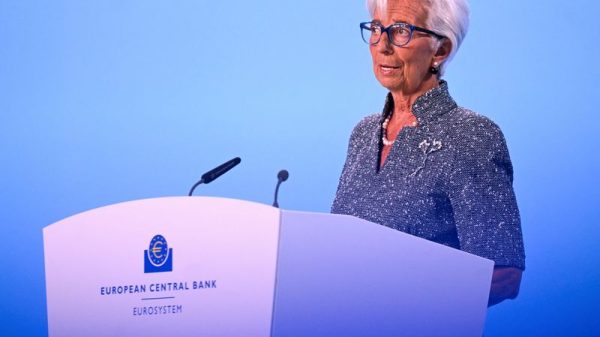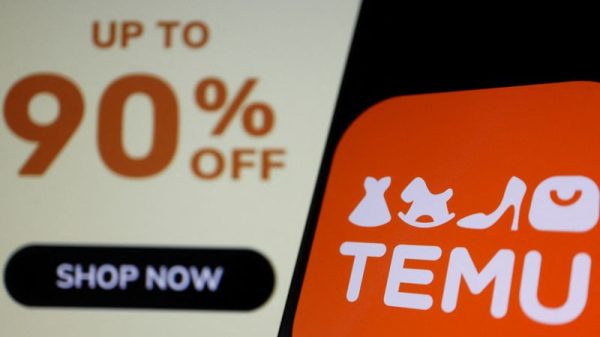Fiserv, Inc. (FISV), a leading global provider of payments and financial services technology solutions, reported a strong financial performance in its Third Quarter 2024 Earnings Conference Call. CEO Frank Bisignano highlighted significant growth with an adjusted earnings per share (EPS) of $2.30, marking a 17% increase from the previous year. Adjusted revenue grew by 7% to $4.9 billion, and the adjusted operating margin improved to 40.2%.
The Merchant Solutions segment saw a remarkable 24% organic revenue growth, and the company raised its full-year guidance for organic revenue growth to 16%-17% and adjusted EPS to $8.73-$8.80. Fiserv also announced a partnership with DoorDash (NASDAQ:DASH), a proof of concept with Walmart (NYSE:WMT), and expanded its Clover offerings, including the new Clover Sport.
Key Takeaways
Adjusted EPS increased by 17% year-over-year to $2.30, with adjusted revenue up 7% to $4.9 billion.
Organic revenue growth reached 15%, driven by a 24% increase in the Merchant Solutions segment.
Free cash flow for the quarter was $1.9 billion, with $3.3 billion accumulated year-to-date.
Fiserv returned $1.3 billion to shareholders through share repurchases and has authorized repurchase of an additional 24 million shares.
Guidance for organic revenue growth and adjusted EPS for the year was raised.
The company announced key partnerships and product launches, including those with DoorDash, Walmart, and new Clover products.
Company Outlook
Fiserv raised its full-year 2024 guidance, with organic revenue growth expected between 16%-17%.
Adjusted EPS guidance increased to a range of $8.73 to $8.80.
The company anticipates strong performance to continue, leveraging strategic partnerships and new initiatives.
Bearish Highlights
The SMB segment experienced a slowdown to 9% growth, affected by easing benefits from Argentina and foreign exchange challenges.
Bullish Highlights
Merchant Solutions segment’s organic revenue growth was robust at 24%.
Financial Solutions segment’s organic revenue grew by 6%, with positive trends in digital payments and issuing.
Misses
No specific misses were mentioned in the provided summary.
Q&A Highlights
Discussions included the integration of capabilities from recent acquisitions like Ondot and Spendlabs.
Clover’s international expansion, particularly the upcoming launch in Brazil, was a focal point.
The company addressed potential merchant churn due to device upgrades, indicating alignment with natural rates.
Fiserv’s third-quarter results demonstrated its ability to deliver strong financial performance and shareholder value. The company’s strategic focus on expanding its product offerings and entering new markets, such as the anticipated launch in Brazil, positions Fiserv for continued growth. The successful execution of its initiatives, along with the positive outlook for the remainder of the year, reflects Fiserv’s commitment to maintaining its leadership in the financial technology industry.
InvestingPro Insights
Fiserv’s strong financial performance in the third quarter of 2024 is further supported by real-time data from InvestingPro. The company’s market capitalization stands at an impressive $114.91 billion, reflecting its significant position in the financial services technology sector.
InvestingPro data shows that Fiserv’s revenue for the last twelve months as of Q2 2024 was $19.78 billion, with a healthy revenue growth of 7.2% over the same period. This aligns well with the company’s reported 7% adjusted revenue growth in the recent earnings call. Moreover, the operating income margin for the last twelve months was 27.23%, indicating Fiserv’s ability to maintain profitability while expanding its operations.
Two particularly relevant InvestingPro Tips for Fiserv are:
1. Fiserv is trading at a low P/E ratio relative to near-term earnings growth, with a PEG ratio of 0.72 for the last twelve months as of Q2 2024. This suggests that the stock may be undervalued considering its growth prospects.
2. The company has shown a strong return over the last three months, which is consistent with the positive financial results and raised guidance announced in the earnings call.
These insights from InvestingPro complement the earnings report, providing investors with additional context for Fiserv’s financial health and market performance. For those seeking a deeper analysis, InvestingPro offers 10 additional tips that could further inform investment decisions regarding Fiserv.
Full transcript – Fiserv Inc (NYSE:FI) Q3 2024:
Operator: Welcome to the Fiserv Third Quarter 2024 Earnings Conference Call. All participants will be in a listen-only mode until the question-and-answer session begins following the presentation. As a reminder, today’s call is being recorded. I would now like to turn the call over to Julie Chariell, Senior Vice President of Investor Relations at Fiserv.
Julie Chariell: Thank you, and good morning. With me on the call today are Frank Bisignano, our Chairman, President and Chief Executive Officer, and Bob Hau, our Chief Financial Officer. Our earnings release and supplemental materials for the quarter are available on the Investor Relations section of fiserv.com. Please refer to these materials for an explanation of the non-GAAP financial measures discussed on this call, along with a reconciliation of those measures to the nearest applicable GAAP measures. Unless otherwise stated, performance references are year-over-year comparisons. Our remarks today will include forward-looking statements about, among other matters, expected operating and financial results and strategic initiatives. Forward-looking statements may differ materially from actual results and are subject to a number of risks and uncertainties. You should refer to the earnings release for a discussion of these risk factors. And now, I’ll turn the call over to Frank.
Frank Bisignano: Thank you, Julie, and thank you all for joining us today. As we share our third quarter results this morning, it is increasingly clear that our position at the intersection of merchant and financial solutions is a strategic advantage. Fiserv delivered another strong quarter, with adjusted earnings per share of $2.30, up 17%, driven by strong revenue growth and further operating margin expansion across our businesses. Adjusted revenue growth was 7% and adjusted operating margin rose 170 basis points to 40.2%. Organic revenue growth was 15%. Our free cash flow was $1.9 billion in the quarter and $3.3 billion year-to-date, and we returned $1.3 billion to shareholders via share repurchase. Businesses and financial institutions are increasingly interconnected, and Fiserv has a key role to play here given our unmatched set of assets across software, data, technology and, of course, scale and experience in moving money. Here are two examples in just the past month. First, we announced this morning with DoorDash, we began implementing a comprehensive embedded finance application poised to be a best-in-class solution for gig economy company. This solution enables DoorDash to offer its delivery contractors a full range of financial services. Within a single app, they can get instant access to wages and rewards, as well as deposit accounts, debit cards and more. Our real-time ledger capability from Finxact manages the transactions and was a key reason why Fiserv was chosen. A Fiserv banking client rounded out the solution as a requisite sponsor. Second, we completed a proof of concept with Walmart where we enabled a real-time Pay by Bank transaction at the point of sale over our proprietary NOW Network. A growing number of merchants are adding Pay by Bank capability to maximize choice for consumers and the emerging capacity for handling such payments in real time offers advantages for Fiserv, merchants and consumers. This capability will be more widely available next year via our NOW Network. Additionally, we teamed up with Walmart Business as a referral partner for Clover as a business management platform, helping Walmart fulfill its goal of helping small businesses and non-profits to better run their businesses. In a separate but related testament to our product strength and position as a partner of choice, today Inc. magazine named Clover to its 2024 Power Partners list, which recognizes the best B2B providers for SMBs. Let me share some of the many highlights of the quarter. It was another strong quarter of growth in the Merchant Solutions segment, with organic revenue up 24%. At Clover, revenue grew 28% and value-added services penetration reached 21%, up 1 percentage point from Q2. In Latin America, we expanded the friends and family Clover pilots in Brazil and Mexico as planned with a full-scale launch coming in December. In Asia Pacific, we went live with our first Clover pilot in Australia in September. We also enabled the Enterprise Commerce Control Center, which allows merchants to monitor and analyze their business and transaction performance across locations, regions and operating segments in a single view. In Financial Solutions, we posted another quarter of strong organic revenue growth at 6%. The build out of CashFlow Central was completed in September and we have our first client gearing up to implement the solution in the next few months. And we continue to migrate clients to Experience Digital, or XD, our new digital banking solution, as we integrate additional solutions into this unique digital ecosystem, including CashFlow Central, real-time payments, Clover and more. We expect to see a multiplying effect on the average revenue per XD user over time. It was another quarter of marquee wins that demonstrate the power of Fiserv’s integrated and value-added offerings. We were chosen to provide merchant acceptance services for a major e-com marketplace and expanded our long-standing partnership with Costco (NASDAQ:COST) to launch a stored value digital wallet. The service enables new payment and reward redemption experiences whether the retailer’s customers are shopping online or in the warehouse. We continue to sign other enterprise merchants onto our value-added solutions. Another long-time enterprise client, Exxon (NYSE:XOM), signed on for a data-as-a-service offering. This solution is used to extract insights from integrated vendor, payments, consumer loyalty and wallet data. And because it runs in a cloud, we can reduce implementation time from months to days. Also in Q3, Ahold Delhaize, a global retailer whose portfolio includes Stop & Shop in the U.S. selected Fiserv as the provider of Pay by Bank services. Alex Lee, a large privately owned operator of multiple food companies, chose our Smart Routing technology for debit cost efficiency. We accelerated our signings of financial institutions as merchant acquirer referral partners. These included banks of all sizes as well as credit unions. Golden 1 Credit Union and America First Credit Union were two of the larger signings in Q3. In our three regions, we continue to see strong client momentum. We expanded our partnership with Netto, a major grocery chain in Europe. We’ll provide several value-added services, including dynamic currency conversion, customer cashback and encryption solutions, in addition to supplying thousands of new PIN pads to accelerate transaction speed across their 700 stores in Poland. In Asia Pac, Fiserv was chosen by foodpanda, a subsidiary of Delivery Hero and one of the world’s leading local delivery companies, to provide payment services across multiple markets in Asia. This strategic partnership spans online, mobile and digital wallets, positioning Fiserv as foodpanda’s primary acquirer in Singapore and Hong Kong, processing over $1 billion in annual spend. We launched Clover Sport at Bombonera in Argentina. This is one of the country’s largest soccer stadiums and home to one of the top teams in the league. Clover’s presence there can add to awareness in the region. To optimize the fan experience for fast and easy concession services, the stadium, through our ISV partner, chose the Clover platform to accept payments in three ways: through QR codes, self-service kiosks and mobile handheld devices. Moving to the Financial Solutions segments, four banks signed on for CashFlow Central in the past three months, including our first credit union for a total of 10 since we announced the initiative a year ago. AvidXchange will be using the CheckFree biller directory to support faster bill payment on its mid-market B2B exchange. In September, we won a competitive bid with Farm Credit Mid-America, a cooperative that reaches across six states. We’ll be converting their loan portfolio to DNA and integrating several other value-added solutions. PNC signed up for our AI-enabled Advance Defense product for enhanced fraud detection in their card issuing business. Equitas Small Finance Bank was the latest India issuer to go live on our India processing hub, successfully launching a new retail and corporate card product with a full-stack offering, including loyalty, offers and real-time fraud management, as well as credit on UPI, India’s real-time account-to-account payment system. And we continue to build our capability here as a market leader with seven of the 10 largest credit card issuers in India on our platform. In September, we hosted 3,000 Fiserv clients and prospects at our annual Client Conference forum. This group of attendees represent nearly 50% of our North American institutional revenue across the Merchant and Financial Solutions segments and nearly 60% of our new business pipeline through 2025. After three days of demos across 75 booths in our Experience Center, over 100 well-attended product and technology information sessions and thousands of client meetings, we strengthened our relationships and partnerships, expanded our pipeline of opportunities and generated enthusiasm for our offerings, setting the stage for continued strong growth in the future. One of the many highlights at Forum this year was our SMB bundle. The premise behind this suite of products is that small- and medium-sized businesses have a complex landscape to navigate for managing their businesses and they prefer a single easy-to-use system. With our own products and partnerships, Fiserv is the only financial technology expert with solutions that cut across the entire SMB value chain. Since the products and the clients for our SMB bundle span our Merchant and Financial Solutions segments, we have the unique opportunity to win business through the integration of solutions across both of our ecosystems. From our merchant ecosystem, we provide acceptance and processing, the Clover POS platform, Clover VAS, including vertical and horizontal business process software, capital, loyalty and gift solutions and the Small Business Index for localized insights. From our financial ecosystem, we provide CashFlow Central because cash management is a fundamental requirement for business success at SMBs. We also provide Optis for business card issuance, SpendTrack for expense management, Zelle for small business and core banking account management and digital banking. While we sell each of these separately now, next year, they will be integrated on our leading platforms. For FIs, the SMB bundle will integrate into digital banking environment such as Fiserv’s Experience Digital or XD platform. For small businesses, the SMB bundle will integrate into the Clover Dashboard and be sold through all Clover channels. Lastly, I want to come back to something I said last quarter. Merchant-related services from Fiserv are back as an opportunity for financial institutions to compete and win. What’s old is new again based on our innovations across the SMB bundle. It gives FIs a deeper view into an SMB’s full financial position. With this knowledge and breadth of product, they can better grow and retain SMB clients and generate deposit and non-interest fees. We couple this capability with tools to help FIs readily find merchant customer leads and onboard them digitally. Showcasing our integrated SMB capabilities generated a lot of interest and ongoing engagement and we expect the SMB bundle to start contributing to growth next year. Turning to our guidance for the rest of the year, we are raising organic revenue growth from 15% to 17% to 16% to 17%, and raising our guidance for adjusted earnings per share to $8.73 to $8.80. As I look across all the new initiatives we are rolling out, I am pleased with how the vision and investment we put into motion five years ago has brought Fiserv to a strong position today, one that’s clearly hard to replicate. The results show that we are executing on mandates for each of our two ecosystems, merchants and financial institutions. This will continue in many ways as we add to our Clover portfolio, extend services to enterprise merchants, expand issuing to new verticals and geographies, enable more real-time payments, modernize core banking systems, add partners, grow internationally, and continue to use distribution data and more. With this foundation of leadership and steady growth firmly established, we are moving to the next generation of solutions that answers the needs across both ecosystems. As the only provider serving both merchants and financial institutions with product breadth and technological scale we serve at the intersection between merchants and fintech, issuers and fintechs, acquiring and cash management, digital wallets and card services, spending and banking data, and many other combinations. This is not a vision. It is here today in our initiatives with DoorDash, Apple (NASDAQ:AAPL), Walmart, U.S. Bank, Palantir (NYSE:PLTR) and others. Of course, these integrated opportunities are in their early stages. As excited as we are about them today, our measure of success will be strong sustainable growth for Fiserv over the medium and longer term. And now, I will turn it over to Bob for more detail on our financial performance.
Bob Hau: Thank you, Frank, and good morning everyone. If you are following along on our slides, I will cover additional detail on total company and segment performance, starting with our financial metrics and trends on Slide 4. Third quarter, again, demonstrated our capability to maintain strong revenue growth and margin expansion. Third quarter total company adjusted revenue grew 7% to $4.9 billion and adjusted operating income grew 12% to $2 billion, resulting in adjusted operating margin of 40.2%, an increase of 170 basis points versus the prior year. Year-to-date, adjusted revenue grew 7% to $14.2 billion and adjusted operating income grew 12% to $5.4 billion, resulting in an adjusted operating margin of 38.2%, an increase of 170 basis points versus the prior year. Organic revenue grew 15% in the quarter, driven by strength in both segments. The transitory contribution from excess inflation in Argentina was 3 points to our total organic growth in the quarter, down from 5 points in Q2. As mentioned during last quarter’s earnings call, dólar turista extended into Q3 and contributed less than 0.5 point of total company organic growth in the quarter. Third quarter adjusted earnings per share was $2.30 compared to $1.96 in the prior year, up 17% on the high end of our full year guidance provided last quarter of 15% to 17%. Year-to-date, our adjusted earnings per share increased 18% to $6.29 compared to $5.34 in the prior year. Free cash flow for the quarter was $1.9 billion, and year-to-date free cash flow was $3.3 billion. As mentioned in prior earnings calls, we expected free cash flow to be much higher in the second half of this year after a lighter first half due to the timing of cash flows for the green tax credit program. The related refund came through in the third quarter. Turning to performance by segment, starting on Slide 5, organic revenue growth in the Merchant Solutions segment was 24% in the quarter and 29% year-to-date. This includes a 6 point benefit from above-average inflation in Argentina in the quarter and a 10 point benefit year-to-date. While inflation remains high, interest rates in Argentina eased in late second quarter and are back to historical averages and, therefore, did not contribute to excess growth this quarter. The continuation of dólar turista contributed nearly 1 percentage point to Merchant organic revenue growth in the quarter and 3 points year-to-date. On Slide 6, we have again included a summary of the impact of excess Argentine inflation and interest on total Fiserv and Merchant segment revenue along with the offsetting headwind from currency devaluation, which impacts adjusted revenue. Adjusted revenue growth for Merchant Solutions was 9% in the quarter and 10% year-to-date. The quarterly results include a 15 percentage point currency headwind largely from the Argentine peso after a sharp devaluation in late December last year. Similar to Q2, the currency headwind to adjusted revenue growth was much higher than the inflation and interest tailwind in the quarter. 2024 has been an outstanding year for new Clover hardware launches. Earlier this year, we brought to market the Kitchen Display System, or KDS XL, to manage orders and improve efficiency in a 24-inches formfactor that larger restaurants demand. We also launched the Kiosk, which allows for self-service ordering, reducing wait times and increasing average tickets. In Q3, we introduced a new version of the Flex (NASDAQ:FLEX) handheld device called the Flex Pocket, which is 25% lighter, 50% thinner and oriented towards restaurant and waitstaff in retail. And most recently, we launched the Clover Compact, an entry-level solution that will help drive TAM expansion and create new VAS revenue opportunities. Now moving to the business lines. Small business organic and adjusted revenue growth in the quarter was 25% and 9%, respectively, on payment volume growth of 4%. This volume growth was similar to Q2 levels. According to a variety of external macro indicators, overall consumer spending growth is slower than last year, but appears stable at a comfortable pace. Fiserv’s small business performance was ahead of our Small Business Index results, which showed year-over-year sales volume growth of 2.3% compared to 3.7% for Q2 and 2.8% for Q3 2023. The difference is likely attributable to our international presence and a slightly different mix of business. Fiserv is more heavily weighted to non-discretionary categories such as food and services, which have been growing faster. Clover revenue grew 28% in the third quarter on an annualized payment volume growth of 15%. VAS penetration increased sequentially by 1 point to 21% in Q3, driven by growth in Clover Capital and the Clover SaaS package. In Q4, we will be rolling out new vertical software plans for retail and services. With this progress, we remain on track to achieve our 2026 Clover targets of $4.5 billion in revenue and VAS penetration of 27%. Enterprise organic and adjusted revenue growth in the quarter was 37% and 17%, respectively, driven by transactions growth of 12% and higher VAS penetration. As with small business, organic growth in enterprise includes some transitory benefit in Argentina. Above-average growth in enterprise business reflects the ramping of a large PayFac from our processing customer to a direct client. Commerce Hub continues to see ongoing traction and is now processing almost 7 times the daily transactions versus Q1 and 2 times when compared to Q2. And clients are increasingly connected to enhanced solutions. Much of the Commerce Hub transaction growth comes from existing clients migrating to the Commerce Hub and the fact that they are now on the platform gives us the opportunity to sell more VAS going forward. Finally, processing organic revenue in the quarter declined by 1%, while adjusted revenue decreased 2%. This business represents the back-end processing we do for our bank and certain ISO partners where they own the merchant relationship. Year-to-date processing organic and adjusted revenue growth were both flat, consistent with our expectation. Adjusted operating income in the Merchant Solutions segment increased 19% to $931 million in the quarter, with adjusted operating margin up 290 basis points to 37.7%. Year-to-date, adjusted operating income increased 22% to $2.6 billion, with adjusted operating margin up 330 basis points to 36.2%. As noted in prior quarters, interest expense from anticipation revenue is recorded below the operating income line. If the interest costs from anticipation were included in the operating income, Merchant adjusted operating margins would have expanded 190 basis points for the quarter and 260 basis points year-to-date. Turning to Slide 7, on the Financial Solutions segment, organic revenue grew 6% in the quarter and year-to-date, in line with our full year outlook of 5% to 7%. Looking at the business lines, digital payments organic and adjusted revenue each grew by 5% in the quarter. Growth in Zelle transactions continue to be strong at 35%. We continue to see demand from clients for digital payments products such as FedNow and RTP integrations. CashFlow Central, our integrated AR/AP solution for SMBs, continues to see high interest from financial institutions. In the last three months, we signed two nearly-$10 billion institutions Amarillo National Bank and Tri Counties Bank. In total, we had four wins in the last three months, bringing the total to 10 since product announcement. In issuing, organic and adjusted revenue grew 7% and 4%, respectively, in the quarter, driven by demand across various verticals, including government and healthcare. During the quarter, we converted the remaining HealthEquity HSA and FSA card accounts to Optis, our issuing processing platform, solidifying our leadership in the healthcare card vertical. Banking organic and adjusted revenue grew 5% in the quarter. Last quarter, we spoke about signing a merchant agreement with Connecticut On-Line Computer Center, known as COCC, which is a client-owned provider of banking technology. In the third quarter, we expanded our relationship to include Experience Digital, or XD, which is our online and mobile banking solution. XD will now be available to the 150 community banks and credit unions on COCC solution. Third quarter adjusted operating income for the Financial Solutions segment was up 5% to $1.1 billion, and adjusted operating margin came in strong at 47.4%. Year-to-date, adjusted operating income for the segment was up 6% to $3.2 billion, with adjusted operating margin up 60 basis points to 45.8%. Now, let me wrap up with some remaining details on the financials. The corporate adjusted operating loss was $112 million in the quarter and $394 million year-to-date, in line with our expectations. The adjusted effective tax rate in the quarter was 18.8% and 19.0% year-to-date. We expect the full year rate to be slightly below 20%. Total debt outstanding was $25.3 billion on September 30. Our debt-to-adjusted-EBITDA ratio went down from 2.8 times in the second quarter to 2.7 times in the third quarter, in line with our target leverage range. During the quarter, we repurchased 8 million shares for $1.3 billion, bringing our total cash return to shareholders for the last 12 months to $5.3 billion and over $16 billion since the 2019 merger. We had 24 million shares remaining authorized for repurchase at the end of the quarter. Turning to Slide 9, as Frank said earlier, we are raising our full year adjusted earnings per share outlook to a range of $8.73 to $8.80, up from $8.65 to $8.80. This is an acceleration in forecasted adjusted EPS growth to 16% to 17% from 15% to 17%. This is also a $0.04 raise at the midpoint from prior guidance and $0.14 from our original guidance. We are raising our 2024 organic revenue growth outlook from 15% to 17% to 16% to 17%. Additionally, we are raising our adjusted margin expansion outlook from more than 135 basis points to at least 150 basis points. Lastly, we are updating our free cash flow guidance from about $4.7 billion to above $4.7 billion, driven by the strong free cash flow in the third quarter and year-to-date. Given the current environment in Argentina, we continue to assume 4 points of benefit from excess inflation and interest this year for the total company and 9 points for Merchant Solutions. We now see the dólar turista program continuing into the fourth quarter, but easing through the end of the year. Our full year outlook of 16% to 17% total company organic growth includes a 4 point transitory benefit from inflation and interest in Argentina and just over 1 point of growth from dólar turista. Excluding these combined transitory factors, 2024 organic revenue growth would be 11% to 12% at the upper end of our medium-term guidance of 9% to 12%. The forecasted impact from foreign currency exchange remains 8.5% and we anticipate will continue to be a stronger though declining headwind to adjusted revenue growth relative to the tailwind from excess inflation and interest. Finally, in the past month, we made progress on three items that many of you have been asking about over the last month. While these do not have an outsized impact on our financials given the scale of our business, they demonstrate our ability to navigate ongoing change in our business in a way that is not disruptive and always open to opportunity. First, as previously reported, we expect Wells Fargo to take ownership of our 40% owned joint venture Wells Fargo Merchant Services on April 1, 2025, at which time, we will receive cash or assets for our portion of the business. Fiserv will continue to provide processing services to Wells’ existing and new merchants along with other related services. As a result, we see no change to our medium-term outlook of 9% to 12% adjusted revenue growth and 15% to 17% adjusted EPS growth from this transaction. Secondly, we extended our merchant processing joint venture with PNC for the fifth time. The relationship dates back to 1996, supporting PNC small business and enterprise clients with hardware and processing services from Fiserv and we expect Clover to have a growing presence from here. And third, the State of Georgia approved our application for a merchant acquirer limited purpose bank charter. This approval from the state allows Fiserv to apply for direct acceptance into the card networks and is anticipated to be operational in 2025. This is a special purpose charter that enables optionality for sponsorship for merchant acquiring. It’s important to clarify that Fiserv is not becoming a bank. Fiserv will not open branches, take deposits or write loans as traditional banks do. We have no intention in doing that and in fact the charter itself does not permit these traditional banking activities. With that, let me turn the call back to Frank for some closing remarks.
Frank Bisignano: Thanks, Bob. I’d like to take a few minutes to discuss our corporate social responsibility initiatives, not because these are investment parameters, but because they represent who we are as a company. Hurricanes Helene and Milton were devastating for millions of people and businesses, including many Fiserv clients. Our response, as always, is to take action and we quickly sent support to the Red Cross and personally delivered supplies to the affected areas. As part of our partnership with the U.S. Chamber of Commerce Foundation and our investment to support its disaster preparedness and recovery effort for small businesses, we provided the Chamber with Fiserv Small Business Index data on the impact of the hurricanes. These granular insights on commerce levels leading up to, during and after these natural disasters are being used to educate policymakers and stakeholders, guide targeted response investments and inform philanthropic support efforts that create and boost small business recovery. Also in the quarter, Fiserv achieved a score of 100 on the Disability Equality Index and was recognized as a Top Veteran-Friendly Company by US Veterans Magazine, each for the third year in a row. The National Bankers Association, a trade organization that represents all minority depository institutions, presented Fiserv with its Corporate Excellence Award, making us the first large-scale tech provider to receive this honor. Finally, we continue to advance our sustainability and green building design strategy. Our Milwaukee headquarters recently achieved LEED Gold status following our Dublin, Ireland and New Jersey Innovation Centers, which achieved LEED Platinum status previously. These are just some examples of how our hard work and dedication show up in many quarters, but most importantly, it showed up in the strong financial performance you just heard. This put us at the top of the IDC FinTech Rankings for a second straight year, and our story today is about how we intend to stay there. I’d like to thank our more than 40,000 employees for their contributions to these significant achievements and for the day-to-day blocking and tackling that has produced consistently strong results. That’s 40 years of building trust, scale and experience, and five years since the merger of achieving innovation through unmatched investment across our merchant and financial ecosystems. So, now, operator, please open the lines for questions.
Operator: Thank you. We would now like to open the phone lines for questions. [Operator Instructions] Our first question comes from Tien-Tsin Huang from JPMorgan. Please go ahead.
Tien-Tsin Huang: Thanks. Good morning. Thanks for the update here. I want to ask on enterprise. It did accelerate nicely more than the transaction growth that you put up there. So, I heard, Bob, you mentioned it was transitory part of it and then there was a PayFac conversion to a retail relationship, it sounds like. So, can you just maybe go through that and what’s a good sustainable level as we think about the fourth quarter?
Bob Hau: Yeah, Tien-Tsin, good morning. So, you’re right, we did see an increase in transactions. Transaction growth in the quarter was up 12% over prior year. That actually matches what we saw in Q1. It’s up from the 8% we saw in Q2. We definitely see some variation, particularly when we bring on new clients, some of them in this enterprise space can be quite large. And as I said in my prepared remarks, we did have a large PayFac begin to really ramp in the third quarter. We will see a little bit of that continue in fourth quarter as they get to full capability or full volume, and then it will return to “more normal levels.” Overall for that business line, we obviously saw very good organic growth, well ahead of the overall company average on an adjusted basis, which again that has also impact from Argentina in it. We feel great about the year-to-date at 11% on an adjusted basis.
Operator: Thank you. Next, we’ll go to the line of Darrin Peller from Wolfe Research. Please go ahead.
Darrin Peller: Guys, thanks. And nice results. Can we just start with — overall the business is showing really strong signs of cross-sell. And I know, Frank, you alluded to that in your prepared remarks and how you’re really packaging together more and more between segments. Maybe just some very specific examples of where you see that shaping up? And then, just if you could reiterate your conviction around the Financial Solutions segment accelerating into ’25. I think you said going to 6% to 8% from 5% to 7%. Just reiterate why and what the driving force is and what you’re seeing? Thanks, guys.
Frank Bisignano: So, I’d like to go back to something I’d like to say the construction of the company, right? I always believe that this was a very strategic set of assets we put together that were highly complementary five years ago. And one quick place to think about it is in merchant and FI, just in total, our ability to be the strategic partner of choice to deliver merchant and FI and put Clover on the front end of that. And then, really there is the power of owning a debit network and the ability of what to bring to our largest institutions and to our client base across merchants. And then, you go a step further and the future of the growth initiatives in terms of us talking about the SMB bundle and the ability to take all the assets we have and integrate them technically now, right? You see us on the front line there with Apple Pay and then you can see us with issuers in another spot and then see us weaving the place together and the ability of the crossroads of merchants and FIs, I think Walmart is a great example of it. I think DoorDash is a great example of it, right? And so, then you think about, okay, you got Finxact, you’re bringing Finxact in as a [handless core] (ph) to be actually a ledger here for the famous Dashers. And then you go, okay, you put XD and Clover together and deliver a capability to every financial institution that runs on us. And you take a look at our international expansion and you look at the work on Commerce Hub, now showing up in the enterprise segment. So, I think the construction of the company with financial institutions all the way through from the largest to a credit union or a local community bank, and then you take on top of that the assets we bring to it. So, I mean, you’re seeing it and then we brought 3,000 people to forum and I think you were there, too, if I am right. And I mean you saw the power of the franchise first-hand. So, we think that’s why we see such sustainable growth for the long term, and we always think we can do our job better, too.
Operator: Thank you. Next, we’ll go to the line of Harshita Rawat from Bernstein. Please go ahead.
Harshita Rawat: Hi, good morning. Frank, can you talk about STAR and Accel, especially given some of the changes happening in the U.S.? Maybe talk about their PINless capabilities [indiscernible] Signature capabilities, how STAR is positioned to grow? Thank you.
Frank Bisignano: Yeah. So, I think one of the things to think about is we always believe that we wanted the capability to compete for transactions for our client benefit, right, for our client benefit. And that window opens up. STAR/Accel is clearly a strategic asset to sit at the crossroads of merchants and financial institutions. We believe our capability is strong on PIN. We have the signature capability. We do have dual-messaging capability. And we give our merchants and issuers choices to compete for transactions at every level. So, that’s the strategy, right? The strategy is to support our client base. We believe it too is one of these steady opportunity you’re not going to see this meteoric rise of transactions, but you’ll continue to see volume share gains and we’ll continue to have an asset in our repertoire to help both our merchants and our financial institutions.
Operator: Thank you. Next, we’ll go to the line of Jason Kupferberg from Bank of America Merrill Lynch (NYSE:BAC). Please go ahead.
Jason Kupferberg: Good morning, guys. Just a couple of questions on Clover. I know revenue growth was steady here, volume growth ticked down a little bit. Just any thoughts on Q4 expectations for those metrics? I think the volume comps get a little bit harder, revenue also next quarter. So, just wanted to get a sense of how we should be thinking about near-term trajectory there. I know you’ve got some new country launches, product launches to support it.
Bob Hau: Yeah, Jason, good morning. So, yes, we continue to see good overall revenue and volume growth out of our Clover solution. As you know, we’ve got a target to be $4.5 billion by 2026. That gets us where we needed about the 28% compound growth rate to achieve that. It’s exactly where we were for the quarter. It’s where we are on a year-to-date basis. A key part of that is continuing to add value-added services that ticked up 1 point to 21% of revenue. Overall, volume remains good. It obviously isn’t as strong as it was last year. Some of that is very strong last year. So, a little bit of a difficult comp, but also the consumer, while still strong, still spending, has certainly eased a bit. We saw that last quarter. We saw that continue again this quarter. But we feel good about where that spending is right now and what we see going into the future.
Operator: Thank you. Next, we’ll go to the line of Dave Koning from Baird. Please go ahead.
Dave Koning: Yeah. Hey, guys. Thanks. Good job. I guess, my question, in the SMB segment, for many quarters, you had kind of teens growth, kind of 13% to 17%. This quarter was 9% despite Clover being in the high-20%s for many quarters in a row. So, maybe what — kind of what’s happening outside of Clover, and then how should we expect that to reaccelerate going forward, or maybe just kind of talk through that?
Bob Hau: Yeah. So, there’s a number of things going on. Obviously, Argentina tailwind has eased quite meaningfully since last year beginning of this year even where we saw in first quarter, 15% benefit to the Merchant segment, easing down in second quarter to 10%, now down to 6%. And that impacts both, actually all three of our segments, but certainly a good portion of SMB volume — excuse me, SMB revenue. The other thing that does play out is anticipation has been quite strong and there is a mix differential between — or benefit differential between SMB and enterprise. We’ve seen particular strength out of the large enterprises down in Argentina. We see that kind of shifting a bit into the next couple of quarters. A bit difficult to predict exactly what’s going to happen into Argentina in the future. I think we’ve gotten it pretty right over the last several quarters and we see that excess or that tailwind continuing to ease. You may have noticed in our presentation and our charts, inflation continues to be a tailwind, although easing meaningfully, but interest has actually returned back to more normal or historic levels. And so that tailwind is subsiding quite meaningfully. And then, of course, if you get to an adjusted revenue basis, FX continues to be a real headwind for us in the quarter for the segments. For the Merchant segment, we saw 15 point impact — negative impact to our adjusted revenue from FX. So, all of those play out in SMB, both in Clover and non-Clover.
Operator: Thank you. Next, we’ll go to the line of Tim Chiodo from UBS. Please go ahead.
Tim Chiodo: Great. Thank you for taking the question. I also want to revisit the Financial Solutions revenue guidance for next year, which is set to slightly accelerate, so from 5% to 7% this year to 6% to 8% next year. When we think about the reasons, there appears to be a good long list of very clear bullets. So, there’s the Target business, there’s Desjardins, there’s Verizon (NYSE:VZ). I believe all of those are expected to go live with their incremental revenue streams next year. And then, of course, there’s the CashFlow Central. So, I was hoping you could touch on or maybe elaborate on any of those particular projects and/or maybe just talk a little bit about the confidence that you have in that reacceleration for next year?
Frank Bisignano: Yeah. So, I think, we were greatly reinforced only a couple of weeks ago at our Client Conference where you heard me talk about the added pipe, the added interest and the amount of opportunity we see to grow our client base. That was not unexpected. That was exactly what we expected for the outcome. Today, on a year-to-date basis, we’re a 6% grower as we were in the quarter. I think when you think about the repertoire, Finxact is growing clients right now, and that will continue to add. You saw us talk about what we’re doing with DoorDash, that’s creating another fundamental, as I use in my simple language, bundle, which is embedded finance, right? Then, you look at this SMB bundle, which I am being deep in every other week reviews for over a year. So, my conviction on the depth of that pipeline will be bringing that online and will be within the numbers. We talk about merchant and FI, but — and that merchant part shows up in the merchant P&L, but the reality is that also is bringing along other opportunity within the banking segment. And then, we do and we’ll continue to have opportunities even within the banking segment outside the U.S. that we see more of than we did before because of the nature and the construct of this company. And you tapped on the items that — you touched on the items that we’re bringing in. I’d add one other one. We believe our long-term opportunity around AI and data for our financial institutions, what I said to medium-sized to smaller banks, we need to be their data and AI engine. And that’s our natural position with them. Now, that’s not in forecast today. We don’t have a number in a box, but we have demand and we have the best data in the industry and data drives AI. So, I would think about it that the fact we’re posting a 6% and we have these engines behind us has such conviction of what we could do. And we can do all of it better as I say every day just in the base business. So that’s why we’ve been able to produce at the level we have — even if you look at our five-year margin, look what we’ve done there, and I’m not saying we’re going to have never-ending margin expansion, but I sure work on it regularly.
Operator: Thank you. Next, we’ll go to the line of Dan Dolev from Mizuho Securities. Please go ahead.
Dan Dolev: Hey, guys. Great results again. Frank, Clover Go and Clover Compact, they look like great solutions from micro sellers. Can you maybe give us a little bit of an update on the strategy and in terms of initial traction that you see on these new products? Thank you.
Frank Bisignano: Yeah. We also see those products as augmentation products for our client base, right? So, I just want you to think about that way we talk about our ability to expand TAM in our own client base by bringing more. We definitely see the Compact playing in the food space. Obviously, we’re early, but you should also think about international, right, that we’re going to be bringing those products outside the U.S. in many cases, where, yes, we will still have software and VAS on top of them, but they may be catering to a different market. And we’re going to have different forms of channel distribution. So, it gets us more software coming down a little bit [scale] (ph) in terms of merchant, but also augmenting our current client base to have a product that can work a little more mobile for them at times, too.
Operator: Thank you. Next, we’ll go to the line of James Faucette from Morgan Stanley. Please go ahead.
James Faucette: Thank you so much. I wanted to follow-up on the SMB bundle and this ties a little bit into Dan’s question, but it seems like there’s a lot of capability expansion that’s happening within the Clover ecosystem and then looking at new ways to go to market. How should we be thinking about — I know you gave some targets for back book and some of those things to get to the $4.5 billion target, but how should we be thinking about like the roles that those will play and if there’s been any change in your thinking in terms of mix or type of customers and such within that Clover target? Thank you.
Frank Bisignano: Yeah. I know there’s only one question allowed, but that’s like five. Good job, James. Let me try it. Like first of all, in some ways, there’s not really — inside this company that there’s a ton of new thought. We always have a lot of R&D going on that historically and the IR team don’t always love me for it, but they’re more apt to talk to you about when we’re getting to market than what’s in the R&D shop. So, this idea about us bringing more capability to the SMB space has always been there. I think if you go back to our acquisition of Ondot and us embedding it in Mobiliti and then it became let’s think about XD and a new product, but then you start saying to yourself, we could deliver this way beyond Clover and XD, we can integrate it all, we can put out Spendlabs acquisition there. Oh boy, we could end up helping LFI’s grow and other channel partners and future partners to be signed up. That’s why we are ultimately a partner of choice for people who want to partner in the SMB space because of our capability. So, I think you got to think about it that, yes, there may be more back book swept up in there because there’s a reason beyond switching out your FD150 for a Clover station, now you have a much broader capability. None of this back book, if it happened, was ever more than our natural kind of rate, which we talked about of merchant churn going from an older device to a newer. But I think you’re seeing the size of the opportunity to actually impact Clover more than we might have because of the full capability set. Thank you. I think you’re on the right track there.
Operator: Thank you. And for our final question, we’ll go to the line of Ramsey El-Assal from Barclays. Please go ahead.
Ramsey El-Assal: Hi, thanks for taking my question. On Clover international expansion, how long does it take to ramp a new country or region from the time you enter the market to when you reach peak run rate? And also, should we expect sort of a steady rhythm of new markets for a while here, or are you going to kind of — should we expect some pauses where you build out and sort of spool up in the countries you’ve already launched in?
Frank Bisignano: Yeah. So, I’m a funny guy. I think we’re going to get to peak run rate never because we’re just going to keep driving more. So, that’s kind of the journey we’re on. But if you want to pick a country like Brazil, right, I’ll be down there on the kick-off of it in December for the launch in Brazil and Mexico. I remember us launching Argentina, call it, four years ago. So, first of all, it’s the full build to get to market. As we launch it, we expect it in Brazil, perfect example, to capture more merchants and more revenue opportunities than we do today immediately. Now, our ability to scale at the peak, we have great partners. I think if you were sitting with our Head of Latin America, he would say Caixa is very motivated. Well, that’s a huge distribution. Now, we’re going to get them trained. They are doing that right now and ready to distribute. So, it affects growth rate in ’25, but I see Brazil as a multiyear build and a multiyear ramp. Not because we weren’t able to get to all the zip codes or towns, if you want to think about it, but adoption. And then, so it’s a multiyear ramp. But much like CashFlow Central of Brazil is in next year’s number at some level, nowhere near where it’ll be three years from now. So, I’d like to thank everybody for your attention today. Please reach out to our IR team with any further questions. And have a great day, and thanks for your participation.
Operator: Thank you all for participating in the Fiserv third quarter 2024 earnings conference call. That concludes today’s call. Please disconnect at this time, and have a great rest of your day.
This article was generated with the support of AI and reviewed by an editor. For more information see our T&C.




























